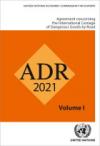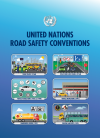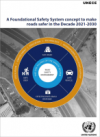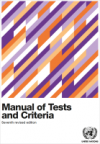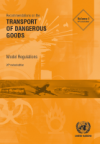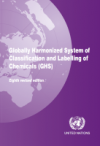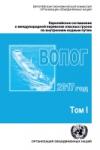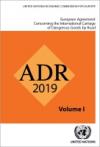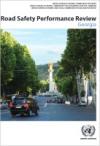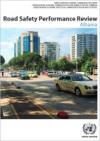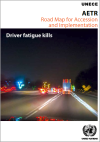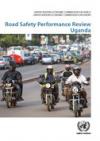Publications
Displaying Results 21 - 40 of 172
- English
In 2010, the United Nations General Assembly (resolution 64/255) proclaimed a Decade of Action for Road Safety ("Decade"). As part of the Sustainable Development Goals (SDGs), the goal of the Decade (2011-2020) is to stabilize and then reduce the forecast level of road traffic deaths around the world.
SDG 3.6 By 2020 halve the number of global deaths and injuries from road traffic accidents
SDG
- Français
L’ADR, fait à Genève le 30 septembre 1957 sous l'égide de la Commission économique des Nations Unies pour l'Europe, est entré en vigueur le 29 janvier 1968.
Cet Accord est destiné à accroître la sécurité du transport international de marchandises dangereuses par route. Ses annexes A et B imposent les conditions dans lesquelles les marchandises dangereuses, lorsqu'elles ne sont pas interdites,
- English
Adopted on 30 September 1957 in Geneva under the auspices of the United Nations Economic Commission for Europe (UNECE), the ADR entered into force on 29 January 1968.
This authoritative Agreement is intended to increase the safety of international transport of dangerous goods by road. Its Annexes A and B contain the technical requirements for road transport, i.e. the conditions under which
- Français
Il existe 59 instruments juridiques onusiens dans le domaine des transports intérieurs qui sont administrés par le Comité des Transports Intérieurs de la Commission Economique des Nations Unies pour l'Europe (CEE-ONU). Parmi les 59 conventions, sept instruments dans le domaine de la sécurité routière sont considérés comme des priorités pour l’adhésion:- 1968 Convention sur la circulation
- Español
Existen 59 instrumentos jurídicos de las Naciones Unidas en el ámbito del transporte terrestre que son administrados por la Comisión Económica de las Naciones Unidas para Europa (CEPE). De las 59 convenciones, siete instrumentos se consideran prioritarios en seguridad vial para la adhesión:- Convención de 1968 sobre la circulación vial;- Convención de 1968 sobre la señalización vial;- Acuerdo
- English
There are 59 United Nations legal instruments in the area of inland transport which are administered by the United Nations Economic Commission for Europe (UNECE). Of the 59 conventions, seven road safety instruments are considered to be priorities for accession:
- 1968 Convention on Road Traffic;
- 1968 Convention on Road Signs and Signals;
- 1958 Agreement concerning the Adoption of
- English
While significant progress in improving road safety has been made in some countries in the last decade, the overall global results are far worse and changes are urgently needed to considerably reduce the number of global road fatalities and injuries. Road traffic injuries constitute the first cause of accidental death globally. Road traffic accidents are responsible for more than 1.3 million
- English
Since the beginning of his mandate, the Special Envoy for Road Safety has been helping to mobilise sustained political commitment towards making road safety a priority; to advocate and raise awareness about the United Nations road safety legal instruments; to share established road safety good practices; and to generate adequate funding for advocacy efforts through
- English
ST/SG/AC.10/11/Rev.7
Sales No. E.20.VIII.1
ISBN 978-92-1-130394-0
eISBN 978-92-1-004503-2
Languages: E, F, (A, C, R, S forthcoming)
How to order this publication?
This publication is also available online for free (download).
The "Manual of Tests and Criteria" contains criteria, test methods and
- English
These recommendations have been developed in the light of technical progress, the advent of new substances and materials, the exigencies of modern transport systems and, above all, the requirement to ensure the safety of people, property and the environment. They are addressed to governments and international organisations concerned with the regulation of the transport of dangerous goods. The
- English
This brochure presents the Resolution on the Deployment of Highly and Fully Automated Vehicles in Road Traffic adopted by the Global Forum for Road Traffic Safety (WP.1) of the United Nations Economic Commission for Europe on 20 September 2018.Download here
- English
The GHS addresses classification of chemicals by types of hazard and proposes harmonized hazard communication elements, including labels and safety data sheets. It aims at ensuring that information on physical hazards and toxicity from chemicals be available in order to enhance the protection of human health and the environment during the handling, transport and use of these chemicals.
The GHS
- English
In 2010, the United Nations General Assembly (resolution 64/255) proclaimed a Decade of Action for Road Safety ("Decade"). As part of the Sustainable Development Goals (SDGs), the goal of the Decade (2011-2020) is to stabilize and then reduce the forecast level of road traffic deaths around the world. SDG 3.6 By 2020 halve the number of global deaths and injuries from road
- English
The European Agreement concerning the International Carriage of Dangerous Goods by Inland Waterways (ADN) done at Geneva on 26 May 2000 under the auspices of the United Nations Economic Commission for Europe (UNECE) and the Central Commission for Navigation on the Rhine (CCNR) has been in force since February 2008. The Agreement currently has eighteen Contracting Parties. The Regulations
- English
Adopted on 30 September 1957 in Geneva under the auspices of the United Nations Economic Commission for Europe (UNECE), the ADR entered into force on 29 January 1968. This authoritative Agreement is intended to increase the safety of international transport of dangerous goods by road. Its Annexes A and B contain the technical requirements for road transport, i.e. the conditions under
- English
Road safety is an important sustainable development goal, yet relatively underappreciated and greatly underfunded. Every year, more than 1.2 million people die and another 50 million are injured in road traffic accidents around the world. Approximately 90% of all road accidents occur in low- and middle-income countries.Recognizing the need to support member States in urgently and effectively
- English
Road safety is an important sustainable development goal, yet relatively underappreciated and greatly underfunded. Every year, more than 1.2 million people die and another 50 million are injured in road traffic accidents around the world. Approximately 90% of all road accidents occur in low- and middle-income countries.Recognizing the need to support member States in urgently and effectively
- English
- English
This report presents the results of the project Safe Future Inland Transport Systems (SafeFITS), which aims to develop a robust road safety decision-making tool to support the most appropriate road safety policies and measures to achieve tangible results.
The SafeFITS tool is composed of three complementary modules:
Intervention analysis: allows the user to examine the effects of single
- English
Every year, as a consequence of road traffic crashes, more than 1.2 million people are killed globally, while another 50 million are injured. Approximately 90% of all road crashes occur in low- and middle-income countries.Even though road safety is an important sustainable development issue, it is yet relatively underappreciated and greatly underfunded. Recognizing the need to support Member


